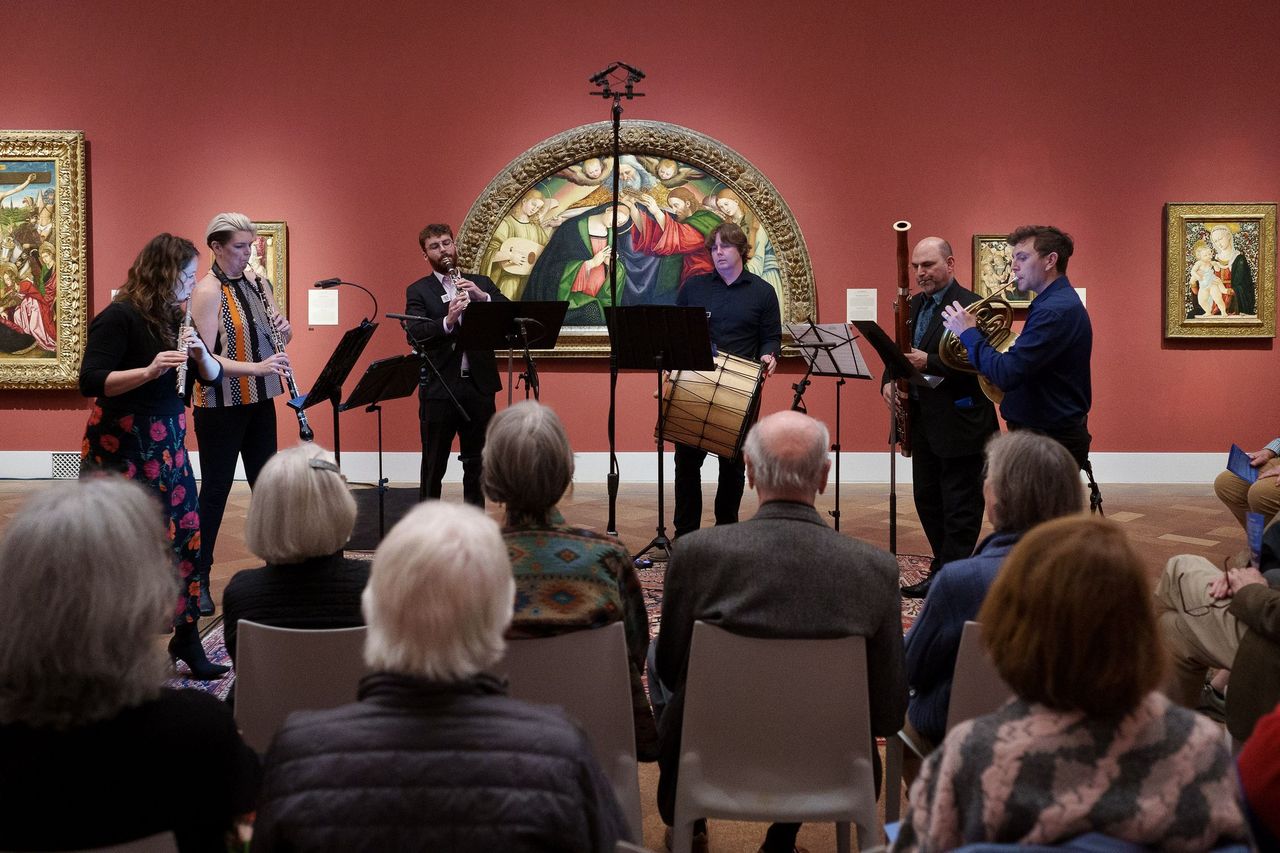Art of Elan Brings Vibrant Chamber Program to the San Diego Museum of Art

(l. to r.) Rose Lombardo, Andrea Overturf, Max Opferkuch, Andrew Watkins, Ryan Simmons & John Degnan [photo(c.) Gary Payne]
In between these entertaining extremes we heard the serious String Quartet No. 7, Op. 87, by Darius Milhaud, a pair of breathtakingly bravura Caprices for solo violin by contemporary composer Kevin Puts, and Vincent Persichetti’s Serenade No. 10, a sophisticated eight-movement duet for harp and flute.
That such an eclectic program not only worked but also charmed the socks off the audience is a tribute to Hatmaker’s programming acumen—I suspect she possesses an extremely rare programming gene. And fortunately, she also knows the San Diego musical community well and manages to persuade the best possible musicians to realize these scores.
Percussion virtuosos Fiona Digney and Andrew Watkins surprised the audience by starting the Reich piece from the rear of the gallery behind the audience, then slowly processed around the outer edges of the audience to center stage, where they completed this rhythmic etude with appropriate flair.
The amazingly prolific Darius Milhaud composed 18 string quartets, but judging by the programming of most string quartets, you might easily conclude that the most recent string quartet by a French composer worth playing is Maurice Ravel’s. String Quartet No. 7 was composed in 1925, when Milhaud was part of Les Six, that informal cabal of French composers that won the approval and patronage of Parisian society in the Roaring Twenties. The work’s opening movement, “Modérément animé,” bristled with visceral counterpoint with more than a touch of Expressionist angst, served boldly with vivid string colors by violinists Cherry Yeung and Pei-Chun Tsai; violist Jason Karlyn, and cellist John Lee. Lee grounded Milhaud’s much quieter second movement, “Doux et sans hâte,” with glowing, lyrical themes, while violist Karlyn’s ardent, beautifully crafted melody suffused the tranquil, poetic “Lent” movement that followed. The finale, “Vif et gai,” lived up to its description with resplendent, lithe exchanges between the violinists, confidently delivered with arresting precision by Yeung and Tsai.
Yeung’s fluent account of the first violin part in the Milhaud String Quartet No. 7 only hinted at her prowess, which was unleashed in two “Caprices” by Kevin Puts from his 2000 Arches for unaccompanied violin. Like the famous–or infamous–Paganini “Caprices,” these solos are constructed to provide the performer with a maximum amount of technical challenge while maintaining a level of lyrical pleasure for the listeners. Sometimes a “Caprice” performer may sacrifice a bit of sonic purity to negotiate particularly strenuous technical challenges, but I am happy to report that Yeung’s gleaming sonority was unfazed by the most brilliant arpeggios and challenging figurations. She performed these pieces with apparent ease, but her audience knew the Olympic-level training they required, and they stood up instantly after her final cadence to give their raucous approval.
In post-World War II America, the music and tutelage of Vincent Persichetti carried unusual importance: orchestras and chamber players liked his conservative, audience-friendly take on modernism, and in his 40 years on the Juilliard School faculty, he trained scores of young composers, including Peter Schickele (aka P.D.Q. Bach) and Philip Glass. His years of teaching made him realize the need for repertory for unusual instruments, so he composed a number of Serenades to fill this need. His Serenade No. 9 is for two recorders; his Serenade No. 12 is for tuba, and his Serenade No. 13 is for two clarinets. On this Art of Elan program, flutist Rose Lombardo and harpist Julie Smith Phillips played Persichetti’s Serenade No. 10 for flute and harp, and the composer’s unfailingly idiomatic approach for each instrument could not have been more appealing. In eight succinct movements, Lombardo offered a catalogue of contrasting themes, some suave and sinuous, others bright and angular, while Phillips used the harp’s wide range and percussive possibilities to suggest an orchestral wave of sound that met and enveloped Lombardo’s cantilenas.
Two years ago, Art of Elan offered an exciting work by the Turkish-American composer Erberk Eryilmaz, and Wednesday’s concert concluded with his 2019 “Raki Havasi” for woodwind quintet and davul, a large traditional Turkish drum. I doubt the museum has ever hosted such racuous, ebullient music–and it was thrilling! The program note from the composer states “the work is inspired by the celebratory drinking tunes and dances of the northwest region of Turkey,” and I will take him at his word, since I have never visited Asia Minor. Of course, the quintet’s buzzy reeds gave the essential Middle Eastern character to the music: Max Opferkuch on clarinet, Andrea Overturf on English Horn, and Ryan Simmons on bassoon. Opferkuch was given the lead, exuberantly delivering the most dazzling, complex melodies that came in unstinting rapid triplets. Flutist Rose Lombardo and horn player John Degnan added to the composer’s exciting layers of sound, and Andrew Watkins confidently handled the imposing davul.
This concert was presented by Art of Elan in partnership with the San Diego Museum of Art in Balboa Park on Wednesday, February 28, 2024.

Ken Herman, a classically trained pianist and organist, has covered music for the San Diego Union, the Los Angeles Times’ San Diego Edition, and for sandiego.com. He has won numerous awards, including first place for Live Performance and Opera Reviews in the 2017, the 2018, and the 2019 Excellence in Journalism Awards competition held by the San Diego Press Club. A Chicago native, he came to San Diego to pursue a graduate degree and stayed.Read more…

Just amazing combinations between the two groups
Ken has captured the excitement and virtuosity of this extraordinary concert! Art of Elan is one of San Diego’s treasures.